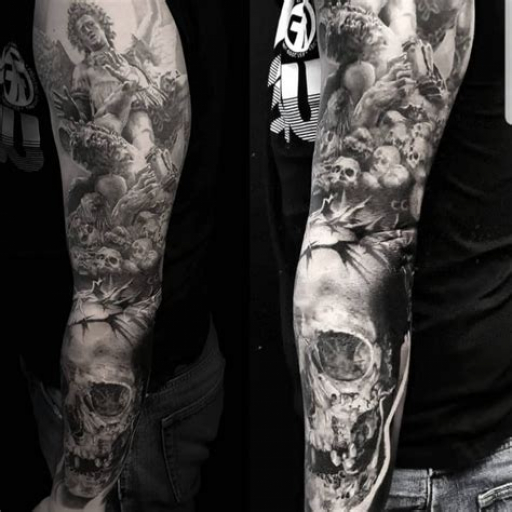Tattoos have always held deep meanings and symbolism, and the good vs evil sleeve tattoo is no different. This powerful and striking design depicts the eternal struggle between light and darkness, good and evil. Whether you choose to represent this battle with religious imagery or through more abstract symbols, a good vs evil sleeve tattoo is sure to make a statement.
The good vs evil sleeve tattoo is a popular choice for both men and women, and there are many different ways to customize the design to make it your own. Some people choose to focus on the religious aspects of the battle between good and evil, while others prefer to create a more personal interpretation of the theme. No matter what your inspiration, a good vs evil sleeve tattoo is sure to be a unique and meaningful piece of body art.

Good Sleeve Descriptions
The good side of the sleeve tattoo can be represented by a variety of symbols, such as angels, crosses, doves, and flowers. These symbols represent purity, hope, love, and peace. The good side of the tattoo can also be depicted through scenes from the Bible or other religious texts. These scenes often show people helping others, performing miracles, or overcoming evil.
One popular way to depict the good vs evil battle in a sleeve tattoo is to use a light vs dark theme. The light side of the tattoo can be represented by white ink, while the dark side can be represented by black ink. This creates a dramatic contrast that helps to emphasize the struggle between good and evil.
Evil Sleeve Descriptions
The evil side of the sleeve tattoo can be represented by a variety of symbols, such as demons, skulls, snakes, and dragons. These symbols represent darkness, evil, temptation, and sin. The evil side of the tattoo can also be depicted through scenes from hell or other dark places. These scenes often show people being tortured, suffering, or being tempted by evil.
Another popular way to depict the good vs evil battle in a sleeve tattoo is to use a heaven vs hell theme. The heaven side of the tattoo can be represented by clouds, angels, and light. The hell side of the tattoo can be represented by fire, demons, and darkness. This creates a powerful contrast that helps to emphasize the struggle between good and evil.
Conclusion
The good vs evil sleeve tattoo is a powerful and meaningful design that can be customized to fit your individual style and beliefs. Whether you choose to focus on the religious aspects of the battle between good and evil or create a more personal interpretation, a good vs evil sleeve tattoo is sure to be a unique and eye-catching piece of body art.
So if you’re looking for a tattoo that will make a statement, consider getting a good vs evil sleeve tattoo. It’s a design that will never go out of style, and it’s sure to be a conversation starter.
FAQ
What are some popular symbols used in good vs evil sleeve tattoos?
Some popular symbols used in good vs evil sleeve tattoos include angels, crosses, doves, flowers, demons, skulls, snakes, and dragons.
What are some different ways to depict the battle between good and evil in a sleeve tattoo?
Some different ways to depict the battle between good and evil in a sleeve tattoo include using a light vs dark theme, a heaven vs hell theme, or a more abstract interpretation.
What are some things to consider when getting a good vs evil sleeve tattoo?
Some things to consider when getting a good vs evil sleeve tattoo include the size, placement, and style of the tattoo. You should also think about the meaning of the tattoo and how it will reflect your personal beliefs.
How can I make my good vs evil sleeve tattoo unique?
You can make your good vs evil sleeve tattoo unique by incorporating personal symbols and imagery. You can also choose a unique placement for the tattoo or experiment with different color combinations.
What are some other popular sleeve tattoo ideas?
Some other popular sleeve tattoo ideas include Japanese sleeves, Polynesian sleeves, and nature-themed sleeves. You can also get a sleeve tattoo that incorporates your favorite hobbies or interests.



